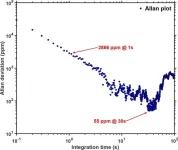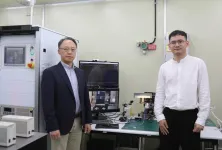(Press-News.org)
Hydrogen gas is a promising energy source with several advantages - it is lightweight, storable, energy-dense, and environmentally friendly compared to fossil fuels, producing no pollutants or greenhouse gas emissions. As such, it has extensive applications across different fields, including transportation, architecture, power generation, and industries. However, hydrogen is highly flammable, and therefore its safe and widespread use requires reliable methods for detecting leaks and ensuring its purity. The need for reliable detection methods has necessitated the development of trace-gas sensing techniques. While several methods have been developed for hydrogen sensing, none offer optimal performance.
One promising method is tunable diode laser absorption spectroscopy (TDLAS) technology, which has gained significant attention for detecting various gases. TDLAS offers several key advantages, including non-contact measurement, in situ detection, high selectivity, rapid response, low cost, and multi-component, multi-parameter measurement capabilities. It works on the principle that gases absorb light at a specific wavelength, resulting in a dark line in the absorption spectrum, known as the absorption line. By measuring the amount of laser light that has been absorbed at this wavelength, the concentration of the gas can be determined. However, detecting low concentrations of hydrogen with TDLAS is difficult because hydrogen has weaker absorption in the infrared region compared to other gases.
To address this issue, a research team from Japan led by Associate Professor Tatsuo Shiina from the Graduate School of Engineering, Chiba University, developed an innovative method for precise hydrogen gas measurement using TDLAS. The team comprised Alifu Xiafukaiti and Nofel Lagrosas from the Graduate School of Engineering, Chiba University, Ippei Asahi from the Shikoku Research Institute Inc., and Shigeru Yamaguchi from the School of Science, Tokai University. Their study was made available online on August 13, 2024, and published in Volume 180 of the journal Optics and Laser Technology on January 01, 2025.
“In this study, we achieved highly sensitive detection of hydrogen gas through meticulous control of pressure and modulation parameters in the TDLAS setup. Additionally, we introduced a calibration-free technique that ensures the adaptability to a wide range of concentrations,” explains Prof. Shiina.
In TDLAS, laser light is passed through a pressurized gas cell called a Herriott multipass cell (HMPC) containing the target gas. The laser’s wavelength is modulated or oscillated around the target absorption line of the gas at a specific frequency to remove any environmental noise. The pressure in HMPC can significantly influence the absorption line width and consequently the modulation parameters under TDLAS.
The researchers carefully analyzed the width of hydrogen’s strongest absorption line at different pressures. Through simulations, the researchers identified the optimal pressure for a broader absorption line width and the most effective modulation parameters within this line width. Their calibration-free technique involved using the first harmonic of the modulated absorption signal to normalize the second harmonic through their ratio, instead of just relying on the second harmonic signal as in conventional TDLAS systems. Additionally, they employed a high-pressure gas cell containing pure hydrogen as a reference to fine-tune the modulating parameters of the laser signal.
Through this innovative approach, the researchers achieved accurate measurements of hydrogen concentrations in a wide detection range from 0.01% to 100%, where 0.01% equals a concentration of just 100 parts per million (ppm). Moreover, the results improved with longer integration times (the time period during which light is allowed to be absorbed). At 0.1 second integration time, the minimum detection limit was 0.3% or 30,000 ppm, which improved to 0.0055% or 55 ppm at 30 seconds integration time. However, beyond 30 seconds the minimum detection limit increased.
“Our system can significantly improve hydrogen detection systems for safety and quality control, facilitating wider adoption of hydrogen fuel. For example, this system can be reliably used for the detection of leakages in hydrogen fuel cell cars,” remarks Prof. Shiina about the potential applications of the study.
To summarize, this pioneering technique could help pave the way for a sustainable future and boost the implementation of hydrogen as an eco-friendly fuel.
About Associate Professor Tatsuo Shiina
Dr. Tatsuo Shiina is currently an Associate Professor at the Graduate School of Engineering at Chiba University, Japan. He received his Ph.D. degree from Tokyo University of Science in 1998. He has published over 80 articles that have received over 300 citations and an impressive h-index of 11. His research focuses on photoelectric measurement and scattering optics. Prof. Shiina is a member of several academic societies including The Japan Society of Applied Physics, The Institute of Electronics, Information and Communication Engineers, The Institute of Electrical Engineers of Japan, The Illuminating Engineering Institute of Japan, and the Optical Society of Japan.
END
Even though psychiatric disorders such as schizophrenia, bipolar disorder, and autism spectrum disorder (ASD) are quite common, their diagnosis and treatment are challenging. While doctors today have a good idea of the clinical symptoms caused by these disorders, our overall understanding of their biological characteristics and underlying physiological causes remain obscure.
Experts agree that problems with synapses—the connections that allow communication between neurons—might be a defining feature ...
Researchers at Chalmers University of Technology in Sweden and at the University of Magdeburg in Germany have developed a novel type of nanomechanical resonator that combines two important features: high mechanical quality and piezoelectricity. This development could open doors to new possibilities in quantum sensing technologies.
Mechanical resonators have been used for centuries for a multitude of applications. A key aspect of these devices is their ability to vibrate at specific frequencies. A well-known example is the tuning fork. When struck, the tuning fork oscillates at its resonance frequency, producing a sound wave within our hearing range. ...
Iliana Ivanova, Commissioner for Innovation, Research, Culture, Education and Youth, said: “Innovation thrives on collaboration, especially when tackling the pressing scientific challenges of our time. The ERC Synergy Grants work with Horizon Europe funding to connect brilliant minds across borders and disciplines, enabling them to push the frontiers of knowledge together. I am particularly delighted to see researchers from countries with historically fewer ERC grants among the awardees, reflecting our mission to ...
The CODICUM project brings together experts in history, literature, and bio-codicology from four Nordic universities to explore medieval knowledge networks. This groundbreaking study combines traditional humanities approaches with cutting-edge biomolecular analysis of fragments from medieval books, written on animal skin.
How book culture shaped medieval Europe
The project will investigate approximately 50,000 medieval Latin book fragments preserved in Nordic collections—one of Europe’s largest archives of medieval book culture.
"These fragments represent an extraordinary treasure trove that can transform our understanding ...
The origins of writing in Mesopotamia lie in the images imprinted by ancient cylinder seals on clay tablets and other artifacts. A research group from the University of Bologna has identified a series of correlations between the designs engraved on these cylinders, dating back around six thousand years, and some of the signs in the proto-cuneiform script that emerged in the city of Uruk, located in what is now southern Iraq, around 3000 BCE.
The study—published in Antiquity—opens new perspectives on ...
Science can be difficult to explain to the public. In fact, any subfield of science can be difficult to explain to another scientist who studies in a different area. Explaining a theoretical science concept to high school students requires a new way of thinking altogether.
This is precisely what researchers at the University of California San Diego did when they orchestrated a dance with high school students at Orange Glen High School in Escondido as a way to explain topological insulators.
The experiment, led by former graduate student Matthew Du and UC San Diego Associate Professor of Chemistry and Biochemistry Joel Yuen-Zhou, was published in Science Advances.
“I ...
Tucson, Arizona, 5 November 2024 – Brain Medicine has launched an ambitious Festschrift series with the first of more than ten planned articles celebrating Dr. Seymour Reichlin's centennial year and his transformative impact on neuroendocrinology. The opening editorial, chronicling his revolutionary insights into brain-hormone interactions, inaugurates what promises to be one of the most comprehensive tributes in the field's history.
“One could be both a physician caring for patients and a scientific investigator,” reflects Dr. Reichlin, whose work spanning nearly 80 years has fundamentally reshaped our understanding of how ...
In the 1960s, Japanese books became immensely popular in South Korea. Interestingly, Korean newspapers often wrote about this trend as if mainly women were interested in learning Japanese.
Osaka Metropolitan University Associate Professor Jinsuk Yang examined South Korean newspaper articles and other historical documents from the 1960s and 1970s to understand why Japanese language learning was often described as something women did, even though men were also learning Japanese. Additionally, Professor Yang studied how women’s ability to speak Japanese affected ...
As buildings age, the demand for effective monitoring of their structural integrity has grown significantly. A breakthrough in nano-optical sensor technology now enables precise, real-time measurement of structural deformation and stability. This innovation promises to reshape the field of structural diagnostics, offering a cost-effective, time-efficient solution that reduces the need for specialized expertise traditionally required in this area.
Led by Dr. Jae Sung Yoon, Principal Researcher at the Nano-lithography & Manufacturing Research Center within the Nano-convergence ...
Bio-based materials may pose a greater health risk to some of the planet’s most important species than the conventional plastics they are designed to replace, a new study has shown.
Such materials are increasingly being advocated as environmentally friendly alternatives to plastics, and used in textiles and products including clothing, wet wipes and period products.
However, microfibres of the materials are emitted into the environment through the laundry cycle, the application of sewage sludge as fertilisers, or the simple wear and tear of textile products.
Despite increasing quantities of bio-based products being produced and sold all over the world, there has been ...










